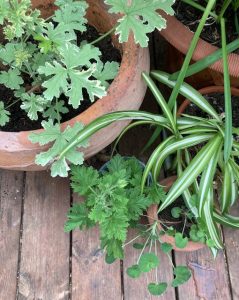My scented pelargoniums have long been released from the greenhouse and are beginning to look their leafy best now, and producing their myriad scents in abundance: cinnamon, lemon, peppermint, spice, cola, and more. These plants are closely related to the bedding pelargoniums that we all plant in terracotta pots and hanging baskets to flower through the summer. Bedding pelargoniums are grown for their beautiful bold coloured flowers – I particularly love those in shades of coral pink and deep red – whereas scented pelargoniums are mostly grown for their scented leaves. This is not only the time to enjoy them, but also a good moment to think about taking cuttings that will overwinter in the greenhouse in the coming winter.
All arise from a number of South African native pelargoniums with naturally scented leaves full of essential oils, a mechanism which most likely developed as a defence against nibbling insects. Pelargonium tomentosum is the origin of all of the mint scented varieties, P. capitatum the rose scented ones, P. graveolens the citrus scented leaves and P. odoratissimum the appley, fruity scents. Breeders have taken these and run with them, creating wonderfully fragranced variations and combinations.

So, some favourites. Although they are mostly not grown for their flowers it is worth noting that some are real multi taskers. ‘Orange Fizz’ is combines pretty spectacular flowers (large and lilac and purple in colour) with wonderfully sherbet-orange scented leaves. ‘Brunswick’ has leaves with a fruity scent and large, bright coral coloured flowers. But generally the flowers of these plants are less spectacular than those of bedding pelargoniums, and they are grown primarily for the scent of their foliage. ‘Attar of Roses’ is the best known of the rose-scented varieties for good reason. It has a lovely rose scent and as such is one of the best of the scented-leaved pelargoniums for culinary use. ‘Shottisham Pet’ has small but intensely ruby coloured flowers and a spicy scent to the leaves and beautiful ‘Clorinda’ has cedar-scented foliage and lovely pink flowers. ‘Grey Lady Plymouth’ has variegated leaves with a minty-rose scent and grows large – it fills a big pot in my garden by the end of the summer. But I particularly love the citrus scented varieties, such as P. ‘Citronella’.
They make up for their lack of showiness win so many ways. First and foremost of course they are just wonderful to brush past or sit next to in the garden, particularly on a hot day when all of the volatile oils are released into the air. Crush a leaf to release the scent and it will linger on your hands all day. The larger growing types make wonderful additions to bunches of garden cut flowers too. Visually the leaves are a good foil for other flowers but they also obviously lkend the bunch unusual and delicious scents. And they can be used in the kitchen. Layer the leaves with sugar to make a scented and flavoured sugar to use in baking, or make a syrup by heating together equal volumes of sugar and water until clear, removing from the heat and then dropping a handful of leaves in to steep as it cools. You can then drizzle rose and lemon and spice scents onto cakes and ice cream, or use them in cocktails.
As they are tender perennials you will need to overwinter them in the greenhouse, and it is also a good idea to take cuttings of them now, as small plants often survive winter better. Take cuttings a few inches long and remove all but a couple of leaves, then push them into gritty, well drained compost and you will have new young plants in no time.










